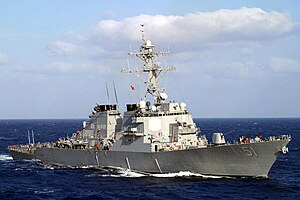
Back USS Arleigh Burke (DDG-51) Czech Arleigh Burke (Schiff) German USS Arleigh Burke (DDG-51) Spanish یواساس آرلی برک Persian USS Arleigh Burke (DDG-51) Finnish USS Arleigh Burke (DDG-51) French ארלי ברק (DDG-51) HE USS Arleigh Burke (DDG-51) Croatian USS Arleigh Burke (DDG 51) Hungarian USS Arleigh Burke ID
 USS Arleigh Burke in the Mediterranean Sea in March 2003
| |
| History | |
|---|---|
| Name | Arleigh Burke |
| Namesake | Arleigh Albert Burke |
| Ordered | 2 April 1985 |
| Builder | Bath Iron Works |
| Laid down | 6 December 1988 |
| Launched | 16 September 1989 |
| Commissioned | 4 July 1991 |
| Homeport | Rota |
| Identification |
|
| Motto | Fast and Feared |
| Status | in active service |
| Badge |  |
| General characteristics | |
| Class and type | Arleigh Burke-class destroyer |
| Displacement | |
| Length | 505 ft (154 m) |
| Beam | 59 ft (18 m) |
| Draft | 31 ft (9.4 m) |
| Installed power |
|
| Propulsion | 2 × shafts |
| Speed | In excess of 30 kn (56 km/h; 35 mph) |
| Range | 4,400 nmi (8,100 km; 5,100 mi) at 20 kn (37 km/h; 23 mph) |
| Complement | |
| Sensors and processing systems |
|
| Electronic warfare & decoys |
|
| Armament |
|
| Aircraft carried | 1 × Sikorsky MH-60R |
USS Arleigh Burke (DDG-51), named for Admiral Arleigh A. Burke, USN (1901–1996), is the lead ship of the Arleigh Burke-class guided-missile destroyers. She was laid down by the Bath Iron Works company at Bath, Maine, on 6 December 1988; launched on 16 September 1989; and commissioned on 4 July 1991.
Arleigh Burke's designers incorporated many lessons learned by the Royal Navy during the Falklands campaign and from the Ticonderoga-class guided-missile cruisers. The Ticonderoga-class cruisers were becoming too expensive to continue building and too difficult to upgrade.[4] Arleigh Burke was the first modern destroyer designed with features meant to lower its radar cross-section, which improves a ship's ability to evade radar detection. She also used a slightly downgraded version of the Aegis Combat System, which allows for launching, tracking, and evading missiles simultaneously. Her all-steel construction provides good protection for her superstructure, while her Collective Protection System allows her to operate in environments contaminated by chemical, biological, or radiological materials.
- ^ "Mk46 MOD 1 Optical Sight System". Kollmorgen. Archived from the original on 30 November 2022. Retrieved 26 January 2023.
- ^ Rockwell, David (12 July 2017). "The Kollmorgen/L-3 KEO Legacy". Teal Group. Archived from the original on 29 May 2023. Retrieved 29 May 2023.
- ^ Hart, Jackie (17 December 2023). "Decoy Launch System Installed Aboard USS Ramage". navy.mil. Archived from the original on 28 April 2016. Retrieved 26 January 2023.
- ^ Tomajczyk, Stephen (2001). Modern U. S. Navy Destroyers. Zenith Imprint. p. 60. ISBN 9781610607339.